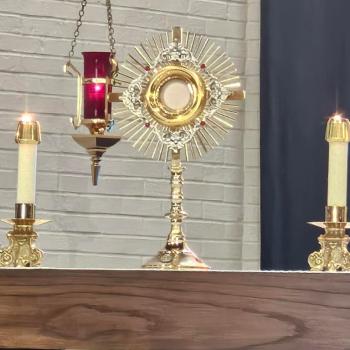Good Victorian that he is, Jonathan is ashamed of the sensual feelings evoked by a vampire's fatal attraction.
Graham infused much of this same sensual imagery in The Love Story of a Mormon. Jacinth's "transformation," as it were, from a young innocent girl to a disciple of Ziba Wayne's Mormonism was no less dramatic. In the chapter entitled "The Kiss of a Saint," Graham detailed the particulars of Jacinth's initiation through Ziba Wayne's words:
"Dear Sister, receive my blessing, and the spiritual baptism which I can give you in the kiss of a Saint." He raised her face, and by some strange magnetism drew her lips to cling to his own, as the bee is fastened to the flower. . . . To the weak, nerveless girl those fantastic seconds appeared as a lifetime. Then she was conscious of release, he drew her arm through his own, and forced the trembling limbs to walk.
Later, Graham emphasized Jacinth's domination by the mesmeric Mormon elder: "No kiss from her lover had ever set upon her soul the burning seal of utter surrender. She knew this stranger had taken some immortal part of herself to imprison as his own property."
Elder Wayne later confided to a fellow missionary his ardor for Jacinth when he declared, "She is like a rose to crush," a Victorian euphemism for sexual conquest.
Jacinth is described by her worried mother as a completely different person. "Jacinth moves about like one in a dream. She seems to be another person." Another passage depicts Jacinth as "no longer a member of her home, save in bodily presence. Even her appearance had changed. Her eyes were wide and mystic, they appeared to gaze beyond with the light of vision. The color in her cheeks was brighter than of yore, like a hectic flush beautifying a consumptive patient."
Other Vampire Parallels
There are a number of similarities between the images of vampires and those of Mormons in the books and films under discussion: Dracula was polygamous, and polygamy, according to the popular press of Graham's day, was the raison d'être for Mormonism. Eternal life, of sorts, was Dracula's promise to his victims, and similar enticement was made by the Mormon elder in Graham's book. To Graham and her loyal readers, the Mormon adherent's fate of worldly bondage and eternal misery was little different from that destiny realized by those in the clutches of Stoker's Count Dracula. To the English, the elder from Utah and the count from Transylvania evoked twin images of a fearful and dreaded predator.
A final similarity between Stoker's vampire and Graham's cardboard Mormon is in the antidote to each respective villain. The classical vampire repellent is the display of a cross or the opening of the vampire's coffin in daylight, thus killing him or her. To the Mormon in Graham's book, it is the "letting in the daylight" of knowledge and orthodox Christianity. Religion, the struggle between good and evil and God and the devil, is at the heart of both Graham's and Stoker's stories. When faced with the decision of whether to pursue Dracula and destroy him, Dr. Van Helsing spells out to Harker, Mina, and the others, in a religious context, the reasons for going forward in their search for the vampire:
But to fail here [in killing the vampire], is not mere life or death. It is that we become as him; that we henceforward become foul things of the night like him -- without heart or conscience, preying on the bodies and the souls of those we love best. To us for ever are the gates of heaven shut; for who shall open them to us again? We go on for all time abhorred by all; a blot on the face of God's sunshine; an arrow in the side of Him who died for man.
Graham the Crusader
Winifred Graham was undoubtedly passionate about her anti-Mormon crusade. She even injected herself into The Love Story of a Mormon through the character of Hester, Ziba Wayne's first wife. After Hester had "seen the light" and told Jacinth of Wayne's scheming plans for her, Hester revealed her own plan: "My idea is to shake the dust of Mormonism from my feet and show up its villainies far and wide. If I can afford to do so, I shall go on a lecturing tour to warn all English-speaking people against this hideous monstrosity."
Graham's active crusade against the Mormons ended in the mid to late 1920s, as it came to be seen as ineffective and out of step with the times. After her husband died in 1920, Graham gravitated to different kinds of Christian belief, including a fascination with mysticism. Graham also allied herself with the beliefs of the controversial Jesuit Montague Summers, who believed that there really were vampires about in the world. Summers was the author of one of the early benchmark works on the history of witchcraft entitled The Vampire: His Kith and Kin, published in 1929. It is of little surprise, then, that Graham, writing in her 1945 autobiography, chose to sum up her earlier anti-Mormon crusading in terminology that, by now, is familiar to us: "I found it thrilling to fight with voice and pen this mighty kingdom working for self-interest, a vampire in fact, sucking the blood of Europe with its wolf-like emissaries in sheep's clothing hot on the heels of British womanhood."




